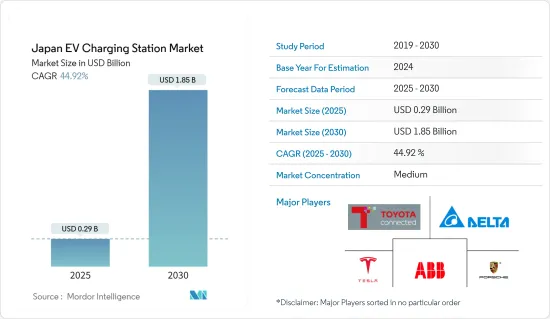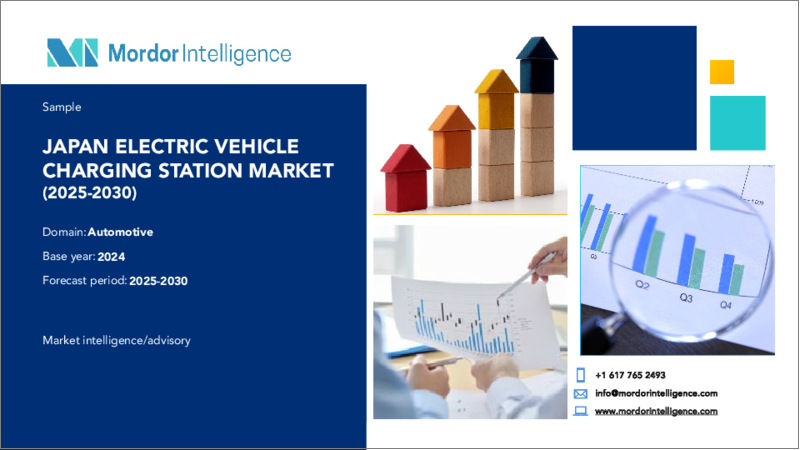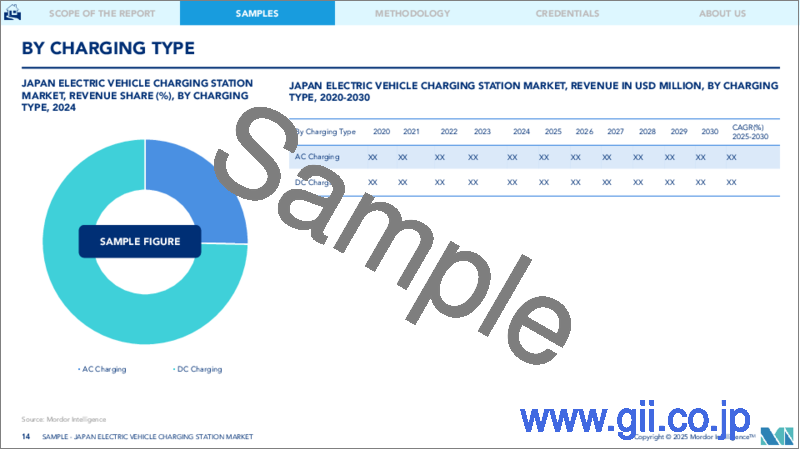|
|
市場調査レポート
商品コード
1692136
日本のEV充電ステーション:市場シェア分析、産業動向と統計、成長予測(2025年~2030年)Japan EV Charging Station - Market Share Analysis, Industry Trends & Statistics, Growth Forecasts (2025 - 2030) |
||||||
カスタマイズ可能
適宜更新あり
|
|||||||
| 日本のEV充電ステーション:市場シェア分析、産業動向と統計、成長予測(2025年~2030年) |
|
出版日: 2025年03月18日
発行: Mordor Intelligence
ページ情報: 英文 90 Pages
納期: 2~3営業日
|
全表示
- 概要
- 目次
日本のEV充電ステーション市場規模は2025年に2億9,000万米ドルと推計され、予測期間(2025年~2030年)のCAGRは44.92%で、2030年には18億5,000万米ドルに達すると予測されます。

日本のEV充電ステーション市場は、急速な成長と進化するダイナミクスを特徴とする状況を示しています。日本では電気自動車(EV)の普及が進み、充電インフラの需要が急増しています。
この需要には、クリーン・エネルギーの推進や炭素排出量の削減を目指す政府の取り組みなど、さまざまな要因が絡んでいます。2050年までにカーボンニュートラルを達成するという日本の公約は、堅牢なEV充電インフラの重要性をさらに強調しています。
同市場は、既存のエネルギー企業、自動車メーカー、充電ソリューションを専門とする新興企業など、多様な企業によって特徴づけられています。これらの企業は、EVユーザーの増加に対応するため、充電ステーションの全国展開に積極的に投資しています。
さらに、充電ネットワークの拡大を加速させるために、さまざまな利害関係者間の提携や協力がますます一般的になってきています。充電時間や利便性に関する消費者の懸念に対応するため、急速充電技術の開発が重視されています。EVバッテリーを素早く補充できる急速充電ステーションは、都市中心部や主要幹線道路沿いで普及しつつあります。
さらに、IoTやAIなどの先進技術によって実現されるスマート充電ソリューションの登場が、EVの充電方法を変えつつあります。これらのソリューションは、充電スケジュールの最適化、遠隔監視、課金統合などの利点を提供し、ユーザー体験とグリッド管理を強化します。
しかし、充電プロトコルの標準化、異なる充電ネットワーク間の相互運用性、送電網の容量と安定性に関する懸念への対応など、課題は山積しています。日本のEV充電ステーション市場が持続的に成長するためには、こうした課題を克服することが重要です。
こうした障害にもかかわらず、政府の支援政策、技術の進歩、EVの環境面での利点に対する意識の高まりが、市場の見通しを有望なものにしています。
日本のEV充電ステーション市場動向
DC充電ステーションが市場を独占
日本の野心的な電動化目標は、電気自動車の急速な普及と相まって、効率的で高速の充電ソリューションへの需要を強めています。直流充電ステーションは、交流充電ステーションに比べて充電時間が大幅に短縮できるため、好ましい選択肢として浮上してきました。
直流充電ステーションの隆盛は、いくつかの要因に起因しています。まず、CHAdeMOやCCS(Combined Charging System)といった急速充電プロトコルに対応していることが、EVメーカーや消費者の嗜好に合致しています。これらのプロトコルは、EVバッテリーの迅速な補充電を促進し、ドライバーに利便性を提供し、ダウンタイムを最小化します。
さらに、人口密度の高い都市部や広範な高速道路網を含む日本の地理的特性は、長距離移動に対応できる充電インフラの配備を必要とします。高速道路沿いや都心部に戦略的に配置されることの多いDC充電ステーションは、外出中のEV所有者に高速で信頼性の高い充電オプションを提供することで、このニーズに対応しています。
さらに、直流充電技術における技術の進歩と革新は、市場での優位性を高める上で極めて重要な役割を果たしています。350kWを超える電力を供給できる超高速充電器などの次世代充電ソリューションの開発は、充電効率とユーザーエクスペリエンスの向上に対する業界のコミットメントを示しています。
さらに、政府機関、エネルギー企業、自動車メーカー、充電インフラ・プロバイダー間の協力やパートナーシップは、日本全土におけるDC充電ステーションの広範な展開を促進してきました。こうした協力的な取り組みにより、充電ネットワークの拡大が促進され、全国のEV所有者にとってよりアクセスしやすく便利なものとなっています。
直流充電ステーションの普及が進んでいるにもかかわらず、充電プロトコルの標準化、異なるネットワーク間の相互運用性、送電網の容量制約といった課題は依然残っています。日本の進化するモビリティ・エコシステムに直流充電インフラをシームレスに統合するためには、こうした課題に対処することが不可欠です。
高速で効率的な充電ソリューションを提供する能力を持つ直流充電スタンドは、日本の電化努力の最前線にあり続け、EV充電インフラ業界の継続的な成長とイノベーションを推進する態勢を整えています。
家庭用充電が市場の大きな成長を牽引
公共充電ステーションには、家庭用充電設備と比べていくつかの利点があります。第一に、専用駐車場や家庭用充電設備を利用できないEV所有者のニーズに応えることであり、これは住宅スペースが限られている人口密集都市部では一般的です。
2022年、日本の都市人口はわずかに減少し、1億1,505万8,684人となり、前年比0.35%減となりました。
さらに、公共の充電ステーションは、EV所有者、特に長距離移動時や長期不在時に、より大きな柔軟性と利便性を提供します。用事を済ませたり、外食したり、レジャーを楽しんだりする際に、充電のために帰宅することなくEVのバッテリーを補充できる信頼性の高い選択肢を提供します。
公共の充電インフラが注目される背景には、主要幹線道路や交通網に沿って充電ステーションが戦略的に配置されていることもあります。戦略的に配置されたこれらのステーションは長距離移動を容易にし、ドライバーの航続距離不安の懸念に対処して、都市間移動への電気自動車の採用を促進します。
さらに、日本の公共充電ネットワークの拡大は、政府機関、エネルギー会社、自動車メーカー、充電インフラ・プロバイダー間の協力関係によって支えられています。こうしたパートナーシップは、充電インフラ配備への多額の投資と、全国的なアクセシビリティとカバレッジの強化につながっています。
しかし、公共充電ステーションが支配的であるにもかかわらず、家庭用充電は依然として充電エコシステム全体の重要な構成要素です。家庭用充電設備は、夜間充電の利便性を提供し、EVオーナーは公共の充電ステーションに行かなくても、満充電の状態で毎日をスタートすることができます。
さらに、家庭用充電ソリューションは、費用対効果が高く、オフピークの電気料金を利用できるため、EV所有者に好まれる可能性があります。家庭用充電器はまた、EV所有者が充電インフラに直接アクセスでき、自宅にいながら充電の進捗状況を監視できるため、管理意識と安心感を与えます。
したがって、日本のEV充電ステーション市場は公共充電インフラが支配的であるが、家庭用充電ソリューションはEV所有者の充電ニーズをサポートする上で引き続き重要な役割を果たしています。公共充電オプションと家庭用充電オプションの共存は、成長する日本の電気自動車エコシステムの多様な嗜好と要件を反映しています。
日本のEV充電ステーション産業の概要
日本のEV充電ステーション市場はかなり統合されており、主要シェアは数社によって占められています。市場の主要企業には、ABB、デルタ電子、トヨタなどがあります。国内の主要企業は、最新技術を開発するために他の企業とジョイント・ベンチャーを立ち上げています。例えば
- 日本では2023年10月、東京近郊の柏の葉で、ワイヤレス充電技術の評価に焦点を当てた電気自動車(EV)パイロット・プロジェクトが開始される予定です。これは、東京大学、千葉大学、そしてブリヂストン、三井不動産、ローム、日本精工など著名企業9社による共同プロジェクトです。
- このイニシアチブは、革新的な"インモーション給電システム"の開発を進めることを目的としています。このシステムは、交差点を通過するEVをワイヤレスで充電するように設計されています。注目すべきは、わずか10秒間の充電で、一般的な電気自動車が0.6マイルの距離を走行するのに十分な電力を供給できると予測されていることです。
その他の特典:
- エクセル形式の市場予測(ME)シート
- 3ヶ月間のアナリスト・サポート
目次
第1章 イントロダクション
- 調査の前提条件
- 調査範囲
第2章 調査手法
第3章 エグゼクティブサマリー
第4章 市場力学
- 市場促進要因
- 日本政府による支援政策とインセンティブが市場成長を促進
- 市場抑制要因
- 充電ステーションの配備と維持に伴う高額な初期費用が市場成長を抑制する見込み
- 業界の魅力- ポーターのファイブフォース分析
- 新規参入業者の脅威
- 買い手/消費者の交渉力
- 供給企業の交渉力
- 代替品の脅威
- 競争企業間の敵対関係
第5章 市場セグメンテーション
- 充電タイプ
- AC充電
- DC充電
- 最終用途
- 家庭用充電
- 公共充電
第6章 競合情勢
- ベンダー市場シェア
- 企業プロファイル
- Charge Point Operators
- Toyota Connected Corporation(Toyota Motor Corporation)
- Tesla Motors Inc.
- Porsche AG(Volkswagen AG)
- EDION Corporation
- Hitachi Ltd
- Delta Electronics Inc.
- Enechange Ltd
- Tritium DCFC Limited
- Kaluza
- WeCharge(Ubiden Co. Ltd)
- ABB Ltd
- TE Connectivity Ltd
- Charge Point Operators
第7章 市場機会と今後の動向
The Japan EV Charging Station Market size is estimated at USD 0.29 billion in 2025, and is expected to reach USD 1.85 billion by 2030, at a CAGR of 44.92% during the forecast period (2025-2030).

The Japanese EV charging stations market reveals a landscape marked by rapid growth and evolving dynamics. With the increasing adoption of electric vehicles (EVs) in Japan, the demand for charging infrastructure has surged.
This demand is fueled by various factors, including government initiatives to promote clean energy and reduce carbon emissions. Japan's commitment to achieving carbon neutrality by 2050 further underscores the importance of robust EV charging infrastructure.
The market is characterized by a diverse range of players, including established energy companies, automotive manufacturers, and startups specializing in charging solutions. These entities are actively investing in the deployment of charging stations across the country to cater to the growing EV user base.
Moreover, partnerships and collaborations between different stakeholders are becoming increasingly common to accelerate the expansion of the charging network. The emphasis is on developing fast-charging technology to address consumer concerns regarding charging time and convenience. Fast-charging stations, capable of replenishing EV batteries quickly, are gaining traction in urban centers and along major highways.
Furthermore, the emergence of smart charging solutions, enabled by advanced technologies such as IoT and AI, is transforming the way EVs are charged. These solutions offer benefits such as optimized charging schedules, remote monitoring, and billing integration, enhancing user experience and grid management.
However, challenges persist, including the need for standardization of charging protocols, interoperability between different charging networks, and addressing concerns related to grid capacity and stability. Overcoming these challenges will be crucial for the sustained growth of the Japanese EV charging stations market.
Despite these obstacles, the outlook for the market remains promising, driven by supportive government policies, technological advancements, and the growing awareness of the environmental benefits of EVs.
Japan EV Charging Station Market Trends
DC Charging Stations are Dominating the Market
Japan's ambitious electrification targets, coupled with the rapid adoption of electric vehicles, have intensified the demand for efficient and high-speed charging solutions. DC charging stations have emerged as a preferred choice due to their ability to deliver significantly faster charging times compared to AC alternatives.
The prominence of DC charging stations can be attributed to several factors. Firstly, their compatibility with fast-charging protocols such as CHAdeMO and CCS (Combined Charging System) aligns with the preferences of EV manufacturers and consumers alike. These protocols facilitate rapid replenishment of EV batteries, offering convenience and minimizing downtime for drivers.
Moreover, Japan's geographical characteristics, including its densely populated urban areas and extensive highway networks, necessitate the deployment of charging infrastructure capable of supporting long-distance travel. DC charging stations, often strategically positioned along highways and in urban centers, address this need by providing fast and reliable charging options for EV owners on the go.
Furthermore, technological advancements and innovation in DC charging technology have played a pivotal role in driving its dominance in the market. The development of next-generation charging solutions, such as ultra-fast chargers capable of delivering power levels exceeding 350 kW, demonstrates the industry's commitment to enhancing charging efficiency and user experience.
Additionally, collaborations and partnerships between government entities, energy companies, automotive manufacturers, and charging infrastructure providers have facilitated the widespread deployment of DC charging stations across Japan. These collaborative efforts have expedited the expansion of the charging network, making it more accessible and convenient for EV owners throughout the country.
Despite the growing prevalence of DC charging stations, challenges such as standardization of charging protocols, interoperability between different networks, and grid capacity, constraints persist. Addressing these challenges will be essential to ensure the seamless integration of DC charging infrastructure into Japan's evolving mobility ecosystem.
With their ability to deliver fast and efficient charging solutions, DC stations are poised to remain at the forefront of Japan's electrification efforts, driving continued growth and innovation in the EV charging infrastructure industry.
Home Charging Driving Major Growth for the Market
Public charging stations offer several advantages over home charging setups. Firstly, they cater to the needs of EV owners who may not have access to private parking or home charging facilities, which is common in densely populated urban areas where residential space is limited.
In 2022, Japan's urban population experienced a slight decline, totaling 115,058,684 individuals, marking a decrease of 0.35% compared to the previous year.
Furthermore, public charging stations provide greater flexibility and convenience for EV owners, especially during long-distance travel or when away from home for extended periods. They offer a reliable option for topping up EV batteries while running errands, dining out, or engaging in leisure activities without the need to return home for charging.
The prominence of public charging infrastructure is also driven by the strategic placement of charging stations along major highways and transportation corridors. These strategically located stations facilitate long-distance travel and promote the adoption of electric vehicles for intercity journeys, addressing range anxiety concerns among drivers.
Moreover, the expansion of Japan's public charging network is supported by collaborations between government agencies, energy companies, automotive manufacturers, and charging infrastructure providers. These partnerships have led to significant investments in charging infrastructure deployment and enhancing accessibility and coverage across the country.
However, despite the dominance of public charging stations, home charging remains an essential component of the overall charging ecosystem. Home charging setups offer the convenience of overnight charging, allowing EV owners to start each day with a full battery without needing to visit a public charging station.
Additionally, home charging solutions may be preferred by EV owners for their cost-effectiveness and the ability to take advantage of off-peak electricity rates. Home chargers also provide a sense of control and security, as EV owners have direct access to their charging infrastructure and can monitor charging progress from the comfort of their homes.
Therefore, while public charging infrastructure dominates the Japanese EV charging station market, home charging solutions continue to play a vital role in supporting the charging needs of EV owners. The coexistence of both public and home charging options reflects the diverse preferences and requirements of Japan's growing electric vehicle ecosystem.
Japan EV Charging Station Industry Overview
The Japanese EV charging station market is fairly consolidated, with a major share being held by a few companies. Some of the major players in the market are ABB, Delta Electronics Inc., and Toyota. The major players in the country are entering joint ventures with other players to develop the latest technologies. For instance,
- In October 2023, in Japan, an electric vehicle (EV) pilot project was set to commence in Kashiwa-no-ha, near Tokyo, focusing on the evaluation of wireless charging technology. It was spearheaded by a collaborative effort involving the University of Tokyo, Chiba University, and nine prominent companies including Bridgestone, Mitsui Fudosan, ROHM, and NSK.
- This initiative aims to advance the development of an innovative "in-motion power supply system." This system is designed to wirelessly charge EVs as they navigate traffic intersections. Notably, a mere 10-second charge is projected to provide sufficient power for a typical electric car to cover a distance of 0.6 miles.
Additional Benefits:
- The market estimate (ME) sheet in Excel format
- 3 months of analyst support
TABLE OF CONTENTS
1 INTRODUCTION
- 1.1 Study Assumptions
- 1.2 Scope of the Study
2 RESEARCH METHODOLOGY
3 EXECUTIVE SUMMARY
4 MARKET DYNAMICS
- 4.1 Market Drivers
- 4.1.1 Supportive Policies and Incentives from the Japanese Government Driving Market Growth
- 4.2 Market Restraints
- 4.2.1 High Upfront Costs Associated with Deploying and Maintaining Charging Stations Anticipated to Restrain Market Growth
- 4.3 Industry Attractiveness - Porter's Five Forces' Analysis
- 4.3.1 Threat of New Entrants
- 4.3.2 Bargaining Power of Buyers/Consumers
- 4.3.3 Bargaining Power of Suppliers
- 4.3.4 Threat of Substitute Products
- 4.3.5 Intensity of Competitive Rivalry
5 MARKET SEGMENTATION
- 5.1 Charging Type
- 5.1.1 AC Charging
- 5.1.2 DC Charging
- 5.2 End Use
- 5.2.1 Home Charging
- 5.2.2 Public Charging
6 COMPETITIVE LANDSCAPE
- 6.1 Vendor Market Share
- 6.2 Company Profiles
- 6.2.1 Charge Point Operators
- 6.2.1.1 Toyota Connected Corporation (Toyota Motor Corporation)
- 6.2.1.2 Tesla Motors Inc.
- 6.2.1.3 Porsche AG (Volkswagen AG)
- 6.2.1.4 EDION Corporation
- 6.2.1.5 Hitachi Ltd
- 6.2.1.6 Delta Electronics Inc.
- 6.2.1.7 Enechange Ltd
- 6.2.1.8 Tritium DCFC Limited
- 6.2.1.9 Kaluza
- 6.2.1.10 WeCharge (Ubiden Co. Ltd)
- 6.2.1.11 ABB Ltd
- 6.2.1.12 TE Connectivity Ltd
- 6.2.1 Charge Point Operators





